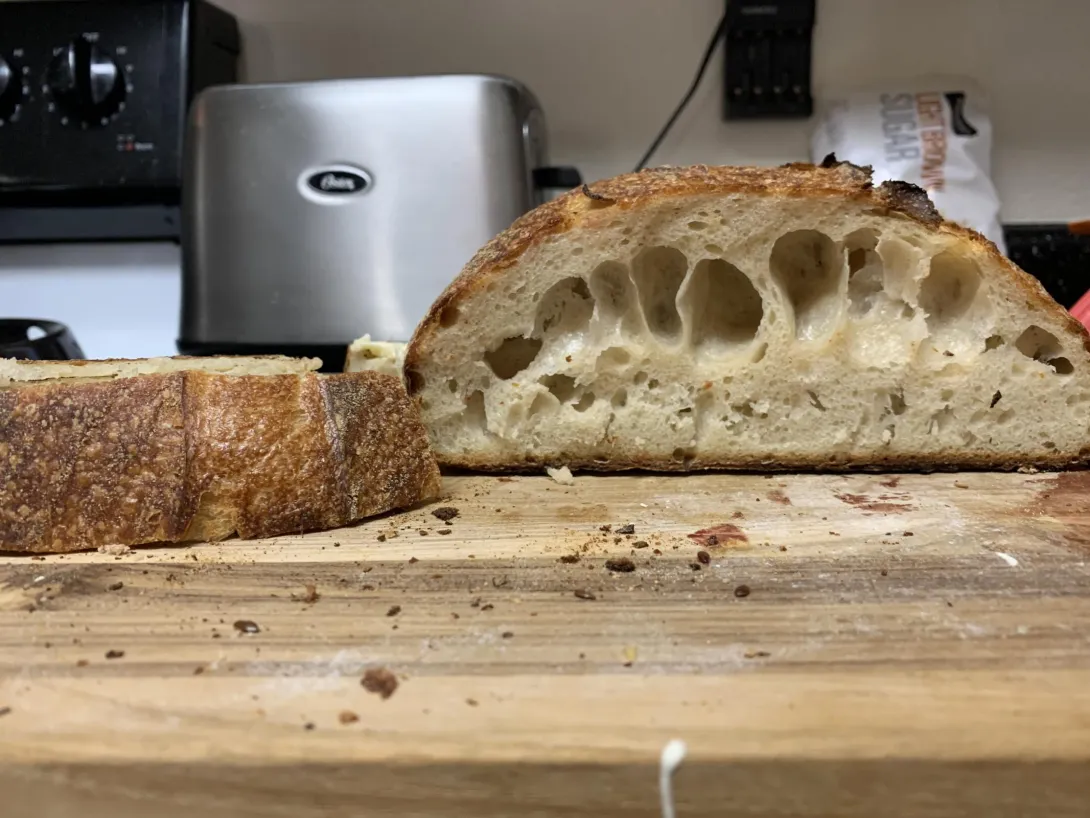
Hi all. I have read a few posts and here and it seems like I’m having some similar issues with my sourdough.
I have baked 4 loafs and all but 1 has been disappointing. My recent loaf seemed like it was going to be good, but still not what I’m hoping for. Dough seems dense with large openings at the top. My process:
starter is based on AP unbleached flour fed over 6 days to get consistency. Starter would double in size daily and kept at 78 degrees. Day before baking starter consisted of 50 grams mature starter, 100 Grams AP, 100 grams water.
then made a levain - 45 grams mature starter, 100 grams AP, 100 grams water. Kept at 78F for 6 hours. Large and small bubbles and over 2x in size.
prepped dough. 948 g flour, 190 g starter, 660 g water. Mixed this together and kept at 78F for about 3 hours and 3 folds.
Dough split into 2 loaves folded one last time and sat for 25 mins before shaping. Shaped and put into baskets. Proofed in fridge at 40F for 14 hours.
oven preheated to 500F, loaves taken from fridge and sat for 30mins at room temperature. Baked covered for 20 mins, baked uncovered for 30 mins. Cooled for 1.5 hours.
photos attached.
Either your starter is not as mature as you think it is yet, or you're misreading the maturity of the levain or ditto with the dough.
Six days is quite young for a starter. Try feeding it for a but longer before the next bake. Slowly increase the feed ratio and wait for it to peak before feeding again. This should build up strength. Baking sourdough is all about reading the starter, levain and dough. That comes with time and practice.
When you say increase the feed ratio I assume this is mature starter to flour. Increasing being that I’m increasing the mount of flour or starter?
thanks again.
Is 1:2:2 = 50g starter + 100g water + 100g flour.
How about slowly lowering the starter % a little each time so it has a healthier feed. Making sure it is bubbling up well each time before increasing the feed.
So over the next few days try 40g starter + 100g water + 100g flour. Only re-feed when peaked. Once you see it's going well then try 30g starter etc.
After a few days and you've reached 20g starter to 100g water + 100g flour, it's bubbling up well and it's strong then try another recipe. But make sure the levain is also mature and you're watching the dough and not the clock.
The levain should be active, bubbly and have a nice aroma. The dough should be aerated and billowy.
Abe,
In the interest of learning, I have a question regarding your advise to lower the percent starter when feeding. I'm wondering what effect that has on things? Does it somehow strengthen the starter? I keep a 100% hydration starter and feed it 2:1:1 and it seems to do the job but maybe I'd get even better results by lowering the percent starter?
Thanks
A modest feed is beneficial. While the yeasts and bacteria aren't as active they won't eat through the food as quickly and keeping the fresh flour and water at a lower percentage helps the pH level to lower. Enough food to help them in their way but not too much it slows things down. But once the starter has matured it'll benefit from a healthier feed. At this stage where the yeast and bacteria are active in order for the starter not to become too acidic and boost the population of yeasts and bacteria a healthier feed would be better. Especially if you're using your starter straight into your final dough. If using a high percentage and your starter is maintained at 2:1:1 it'll produce poorer results and might even have a detrimental affect on the final dough. A healthier feed keeps them happy and balances out the starter's acidity and flavour. A levain does pretty much the same thing. I'd certainly increase it slowly to 1:2:2 and see what happens. For myself I build about 100g and store it in the fridge. When it comes to baking I'll take a little off and build a levain. Once my starter runs low (e.g. down to a few grams) I'll feed it back up to 100g ish, allow it to double and back into the fridge it goes. Every so often I'll just use straight from the fridge but it'll be just a few grams in the dough and a long ferment.
Thanks for the info. I will begin to change things up today and monitor the results.
Agreed - under fermented. Try about 5 hours at that temp and see if it helps. However...watch the dough not the clock.
Thanks. When you say try 5 hours at that temp. What part of the process are you referring to? The bulk ferment?
Yes, sorry. I was referring to the bulk.
If you haven't already, take a look at this fermentation table: http://www.thefreshloaf.com/node/5381/sourdough-rise-time-table.
That table was useful. Based on that table and guidance from the comments I am going to push my bulk ferment to 5 hours. I did reduce my starter to flour ratio to something like 25/100/100 and the volume tripled so I will continue with this for a few days and try again.